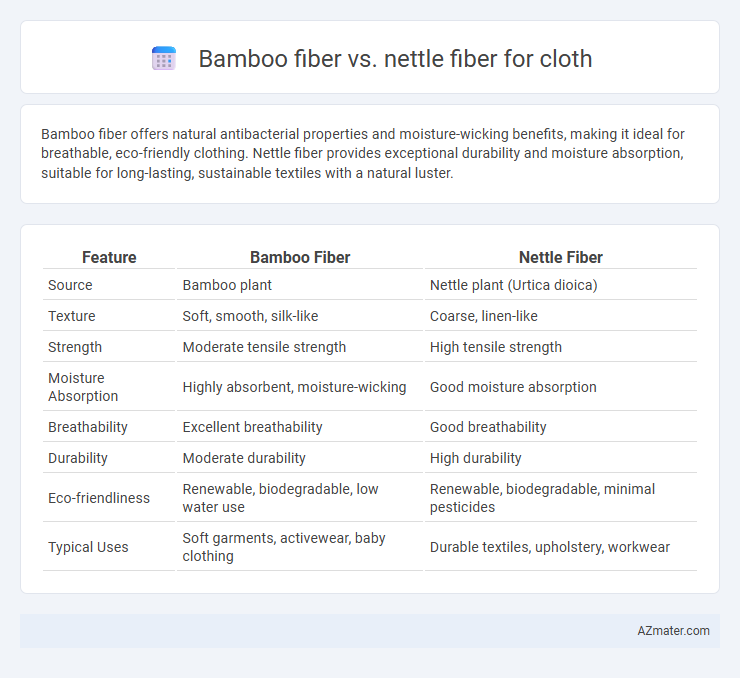Bamboo fiber offers natural antibacterial properties and moisture-wicking benefits, making it ideal for breathable, eco-friendly clothing. Nettle fiber provides exceptional durability and moisture absorption, suitable for long-lasting, sustainable textiles with a natural luster.
Table of Comparison
| Feature | Bamboo Fiber | Nettle Fiber |
|---|---|---|
| Source | Bamboo plant | Nettle plant (Urtica dioica) |
| Texture | Soft, smooth, silk-like | Coarse, linen-like |
| Strength | Moderate tensile strength | High tensile strength |
| Moisture Absorption | Highly absorbent, moisture-wicking | Good moisture absorption |
| Breathability | Excellent breathability | Good breathability |
| Durability | Moderate durability | High durability |
| Eco-friendliness | Renewable, biodegradable, low water use | Renewable, biodegradable, minimal pesticides |
| Typical Uses | Soft garments, activewear, baby clothing | Durable textiles, upholstery, workwear |
Overview of Bamboo and Nettle Fibers
Bamboo fiber is derived from the pulp of bamboo grass, known for its softness, natural antibacterial properties, and moisture-wicking abilities, making it popular in eco-friendly textile production. Nettle fiber, obtained from the stems of stinging nettle plants, offers durability, breathability, and a silk-like texture, valued for its strength and environmental sustainability in fabric manufacturing. Both fibers provide biodegradable alternatives to synthetic textiles, with bamboo fibers excelling in softness and moisture control, while nettle fibers stand out for structural integrity and resilience.
Historical Use of Bamboo and Nettle in Textiles
Bamboo fiber has been used in textiles for centuries, particularly in East Asia, where it was valued for its natural antibacterial properties and softness, making it ideal for clothing and home fabrics. Nettle fiber, dating back to ancient Europe and Asia, was historically woven into strong, durable textiles used for clothing, fishing nets, and ropes due to its fibrous strength and breathability. Both fibers reflect sustainable textile practices, with bamboo favored for its rapid growth and nettle appreciated for its low environmental impact and resilience.
Cultivation and Sustainability Comparison
Bamboo fiber cultivation requires minimal pesticides and thrives rapidly, enabling high yields with low environmental impact, while nettle fiber grows naturally in wild or marginal lands without intensive farming inputs. Bamboo's fast growth sequesters more carbon, but its processing can involve chemical treatments that affect sustainability. Nettle fiber production is often more labor-intensive but uses less water and energy, making it a sustainable option with lower ecological footprint in fiber processing.
Fiber Extraction Processes
Bamboo fiber extraction primarily involves mechanical crushing and enzymatic retting to separate fibers from the bamboo stalk, producing soft, breathable fabric ideal for clothing. Nettle fiber extraction uses retting, either by water or dew, to break down pectin binding fibers, followed by drying and combing to yield strong, durable fibers often used in eco-friendly textiles. Both processes emphasize eco-friendly methods, but bamboo fiber extraction tends to be more industrialized, while nettle fiber retains traditional, small-scale processing benefits.
Environmental Impact Analysis
Bamboo fiber production generates fewer greenhouse gas emissions and requires less water compared to nettle fiber, making it a more sustainable choice for eco-friendly textiles. However, nettle fiber cultivation demands minimal pesticides and fertilizers, promoting soil health and biodiversity conservation. The biodegradability of both fibers contributes to reducing textile waste, but nettle fiber's low environmental input provides a superior ecological footprint in sustainable fabric manufacturing.
Texture and Comfort of Bamboo vs. Nettle Cloth
Bamboo fiber offers a smooth, silky texture that feels exceptionally soft and breathable against the skin, making it ideal for comfortable, lightweight clothing. Nettle fiber, while slightly rougher than bamboo, becomes softer with washing and provides a natural, breathable fabric with good durability and moisture-wicking properties. Compared to nettle cloth, bamboo fabric typically offers superior softness and a gentler touch, enhancing overall comfort for daily wear.
Durability and Longevity of Fabrics
Bamboo fiber exhibits impressive durability due to its natural antimicrobial properties and strong cellulose structure, making it resistant to wear and tear over time. Nettle fiber, known for its robust bast fibers, offers exceptional strength and abrasion resistance, contributing to the longevity of fabrics crafted from it. Both materials provide sustainable alternatives, but nettle fiber often surpasses bamboo in tensile strength, resulting in longer-lasting textiles.
Breathability and Moisture-Wicking Properties
Bamboo fiber exhibits excellent breathability due to its micro-gaps and micro-holes structure, allowing air to circulate freely and keeping the fabric cool and comfortable. Nettle fiber, while slightly less porous than bamboo, offers strong moisture-wicking properties by efficiently absorbing and releasing sweat, making it ideal for activewear. Both fibers are environmentally sustainable, but bamboo's superior breathability combined with nettle's effective moisture management provides versatile options for performance textiles.
Dyeing and Color Retention Capabilities
Bamboo fiber exhibits superior dye absorption due to its porous structure, resulting in vibrant, long-lasting colors ideal for clothing. Nettle fiber, while eco-friendly, tends to have lower dye affinity, often requiring pre-treatment to enhance color retention and achieve uniform shades. The natural cellulose content in bamboo enhances dye bonding, making it a preferred choice for textiles requiring durable and bright coloration.
Cost and Market Availability
Bamboo fiber is generally more cost-effective due to its high yield and faster growth cycle, making it widely available in the textile market. Nettle fiber, though eco-friendly and durable, tends to be more expensive and less commonly found because of labor-intensive extraction processes and limited cultivation. Market availability favors bamboo fiber for mass production, while nettle fiber remains a niche product in sustainable textile sectors.

Infographic: Bamboo fiber vs Nettle fiber for Cloth
 azmater.com
azmater.com